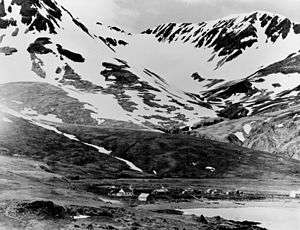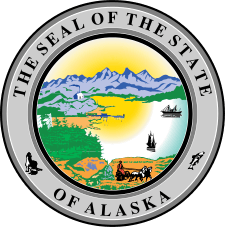Japanese occupation of Attu
| Japanese occupation of Attu | |||||||
|---|---|---|---|---|---|---|---|
| Part of the American Theater and the Pacific Theater of World War II | |||||||
 Four Japanese seaplanes landed at Holtz Bay, Attu Island on 7 November 1942. Photo taken by American surveillance aircraft. | |||||||
| |||||||
| Belligerents | |||||||
|
|
| ||||||
| Commanders and leaders | |||||||
| N/A |
| ||||||
| Strength | |||||||
| N/A | 1,140 - 2,900 | ||||||
| Casualties and losses | |||||||
|
1 civilian killed 46 civilians captured | unknown | ||||||
The Japanese occupation of Attu was the result of an invasion of the Aleutian Islands during World War II. Imperial Japanese Army troops landed on 6 June 1942 at the same time as the invasion of Kiska. The occupation ended with the Allied victory in the Battle of Attu on 30 May 1943.
Occupation
In May 1942, the Japanese began a campaign against Midway, their objective being to occupy the islands and destroy the remaining United States Navy forces in the Pacific. In order to deceive the American Pacific Fleet, a diversionary attack was ordered to take place in the Aleutians, thus beginning the Aleutian Islands Campaign. During the Battle of Midway, Japanese forces were repulsed in a decisive action, meanwhile on 6 June, Japanese naval forces under Boshirō Hosogaya landed troops unopposed at Kiska and Attu islands. A force consisting of 1,140 infantry under Major Matsutoshi Hosumi took control of the island and captured forty-five Aleut civilians and a school teacher. The school teacher's husband was killed during the invasion; the Japanese Army was suspected of executing him. All of the prisoners were eventually removed to Japan.

After landing, the soldiers began constructing an airbase and fortifications. The nearest American forces were on Unalaska Island at Dutch Harbor and at an airbase on Adak Island. Throughout the occupation, American air and naval forces bombarded the island. Initially the Japanese intended to hold the Aleutians only until the winter of 1942; however, the occupation continued into 1943 in order to deny the Americans use of the islands. In August 1942, the garrison of Attu was moved to Kiska to help repel a suspected American attack. From August to October 1942, Attu was unoccupied until a 2,900-man force under Colonel Yasuyo Yamasaki arrived. The new garrison of Attu continued constructing the airfield and fortifications until 11 May 1943, when a 15,000 man army of American troops landed. On 12 May, I-31 was forced to surface five miles northeast of Chichagof Harbor, she was then sunk in a surface engagement with USS Edwards.

Allied forces under General John L. DeWitt took control of the island on 30 May after the remaining Japanese troops conducted a massive banzai charge. American forces lost 549 killed and 1,148 wounded, another 2,100 evacuated due to weather-related injuries. During the Battle of Attu, all but 29 men of the Japanese garrison were killed. The occupation ended with an American victory and American forces deemed the half-completed airfield as not ideally situated. After building a new airfield the Americans launched bomber attacks against the Japanese home islands for the remainder of the war [1]
Attu village was abandoned after the war, and surviving members of Japanese internment were moved to other islands after the war. In 2012, for the 70th anniversary of the occupation, a memorial to Attu village was dedicated at the former site of the town.
See also
References
- ↑ Brian Garfield, The Thousand-Mile War: World War II in Alaska and the Aleutians
- Fern Chandonnet (2007-09-15). Alaska at War, 1941-1945. University of Alaska Press. pp. 23–26. ISBN 978-1-60223-013-2.
- Diane Olthuis (2006-07-01). It Happened in Alaska. Globe Pequot Press. p. 119. ISBN 978-0-7627-3908-0.
- Paulin, Jim. "Memorial placed in Attu honoring villagers". The Bristol Bay Times. Retrieved 3 March 2014.

